A Philosophical Analysis: Abortion, Euthanasia, and Moral Dilemmas
VerifiedAdded on 2022/11/26
|10
|2737
|310
Essay
AI Summary
This essay provides a philosophical analysis of the moral and ethical issues surrounding abortion and euthanasia, drawing insights from the movie "If These Walls Could Talk." The analysis examines three different scenarios presented in the film, exploring the diverse reasons women consider or reject abortion. It delves into deontological, utilitarian, and virtue ethics frameworks to evaluate the morality of abortion and euthanasia, considering the perspectives of various stakeholders. The essay also discusses the types of abortion that could be considered euthanasia, the ethical differences between euthanizing animals and humans, and the moral justifications for euthanasia in specific contexts. Finally, it addresses how the author would respond to those who disagree with their stances on abortion and euthanasia, emphasizing the importance of considering the physical and mental health consequences of abortion and the ethical considerations of end-of-life care.
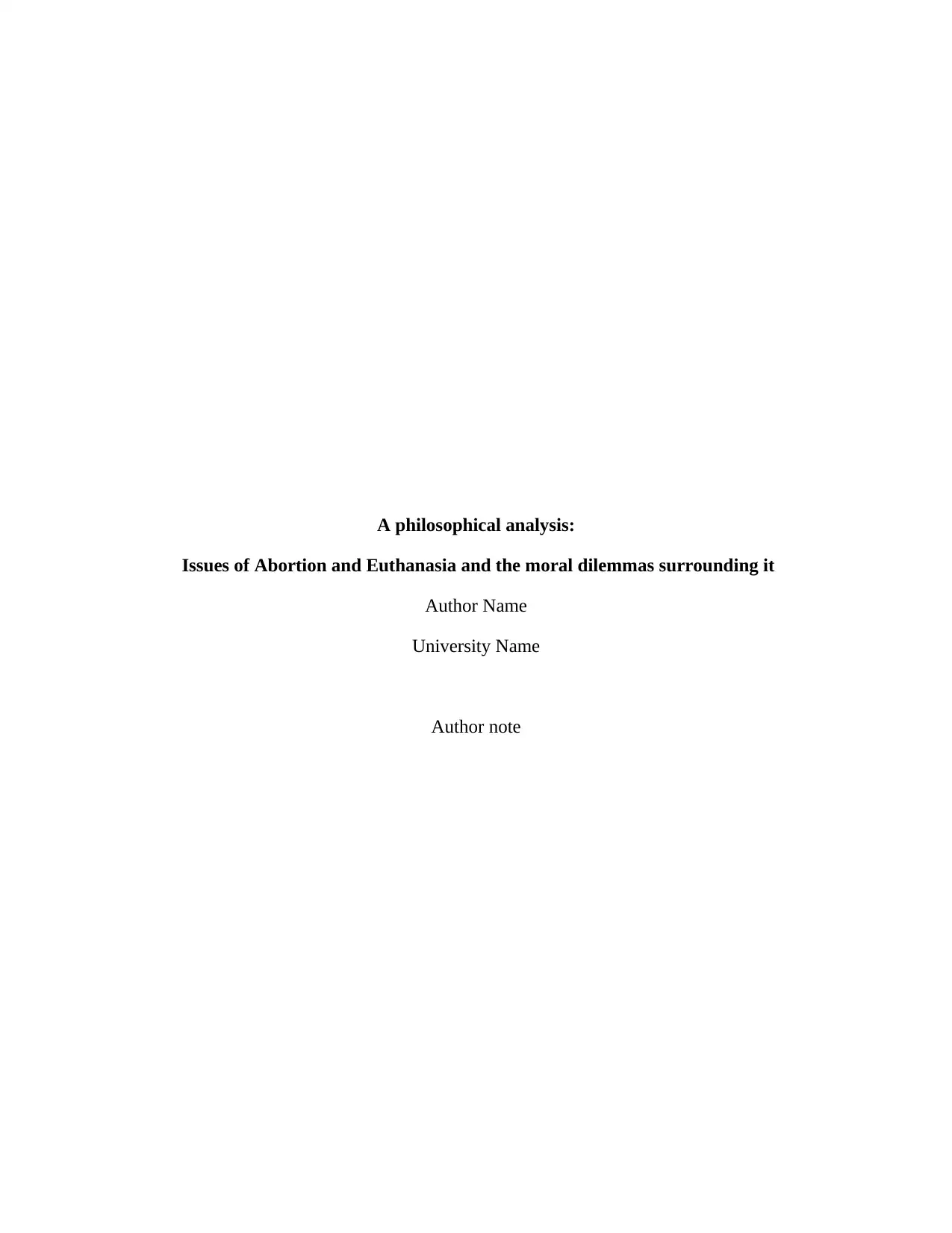
A philosophical analysis:
Issues of Abortion and Euthanasia and the moral dilemmas surrounding it
Author Name
University Name
Author note
Issues of Abortion and Euthanasia and the moral dilemmas surrounding it
Author Name
University Name
Author note
Paraphrase This Document
Need a fresh take? Get an instant paraphrase of this document with our AI Paraphraser
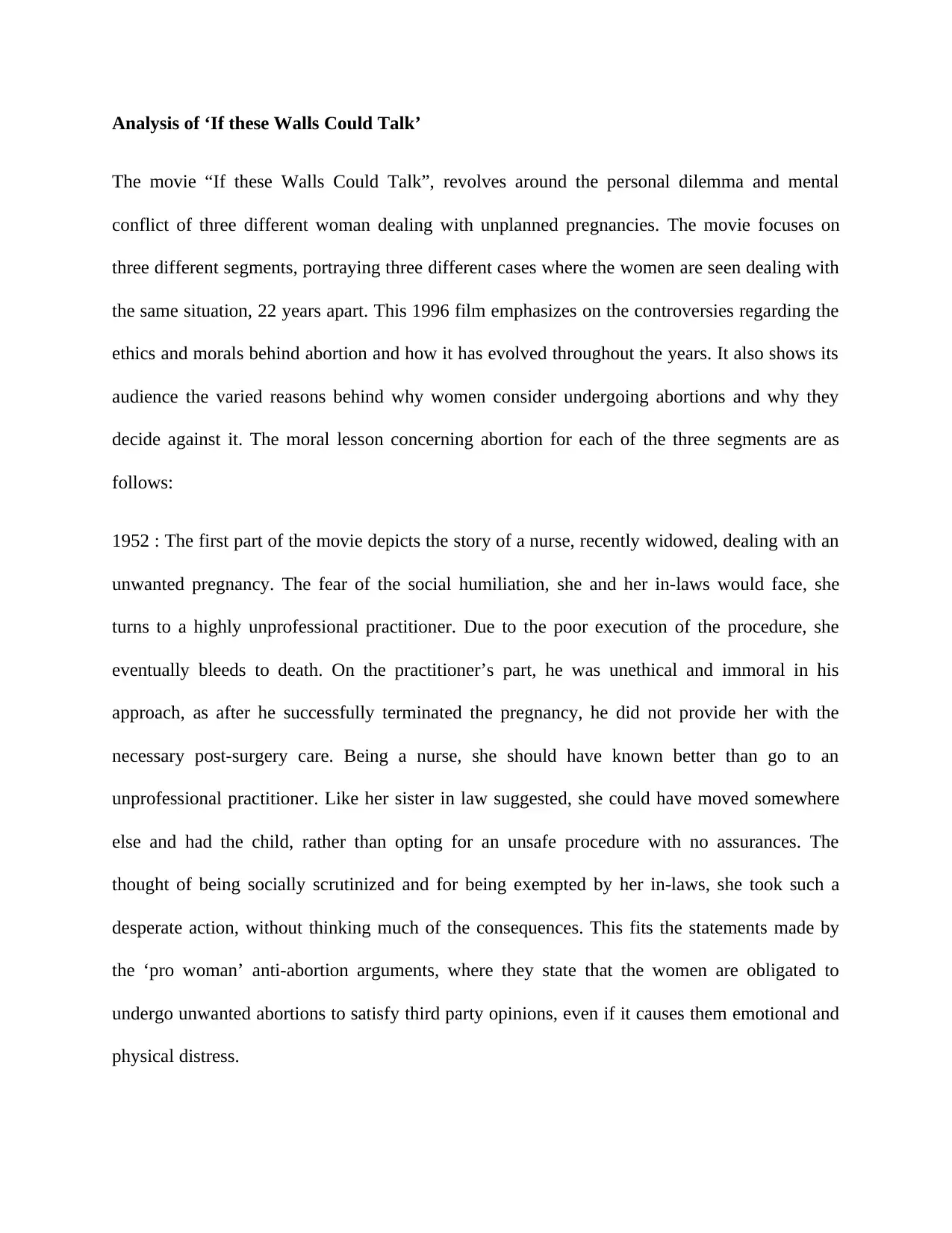
Analysis of ‘If these Walls Could Talk’
The movie “If these Walls Could Talk”, revolves around the personal dilemma and mental
conflict of three different woman dealing with unplanned pregnancies. The movie focuses on
three different segments, portraying three different cases where the women are seen dealing with
the same situation, 22 years apart. This 1996 film emphasizes on the controversies regarding the
ethics and morals behind abortion and how it has evolved throughout the years. It also shows its
audience the varied reasons behind why women consider undergoing abortions and why they
decide against it. The moral lesson concerning abortion for each of the three segments are as
follows:
1952 : The first part of the movie depicts the story of a nurse, recently widowed, dealing with an
unwanted pregnancy. The fear of the social humiliation, she and her in-laws would face, she
turns to a highly unprofessional practitioner. Due to the poor execution of the procedure, she
eventually bleeds to death. On the practitioner’s part, he was unethical and immoral in his
approach, as after he successfully terminated the pregnancy, he did not provide her with the
necessary post-surgery care. Being a nurse, she should have known better than go to an
unprofessional practitioner. Like her sister in law suggested, she could have moved somewhere
else and had the child, rather than opting for an unsafe procedure with no assurances. The
thought of being socially scrutinized and for being exempted by her in-laws, she took such a
desperate action, without thinking much of the consequences. This fits the statements made by
the ‘pro woman’ anti-abortion arguments, where they state that the women are obligated to
undergo unwanted abortions to satisfy third party opinions, even if it causes them emotional and
physical distress.
The movie “If these Walls Could Talk”, revolves around the personal dilemma and mental
conflict of three different woman dealing with unplanned pregnancies. The movie focuses on
three different segments, portraying three different cases where the women are seen dealing with
the same situation, 22 years apart. This 1996 film emphasizes on the controversies regarding the
ethics and morals behind abortion and how it has evolved throughout the years. It also shows its
audience the varied reasons behind why women consider undergoing abortions and why they
decide against it. The moral lesson concerning abortion for each of the three segments are as
follows:
1952 : The first part of the movie depicts the story of a nurse, recently widowed, dealing with an
unwanted pregnancy. The fear of the social humiliation, she and her in-laws would face, she
turns to a highly unprofessional practitioner. Due to the poor execution of the procedure, she
eventually bleeds to death. On the practitioner’s part, he was unethical and immoral in his
approach, as after he successfully terminated the pregnancy, he did not provide her with the
necessary post-surgery care. Being a nurse, she should have known better than go to an
unprofessional practitioner. Like her sister in law suggested, she could have moved somewhere
else and had the child, rather than opting for an unsafe procedure with no assurances. The
thought of being socially scrutinized and for being exempted by her in-laws, she took such a
desperate action, without thinking much of the consequences. This fits the statements made by
the ‘pro woman’ anti-abortion arguments, where they state that the women are obligated to
undergo unwanted abortions to satisfy third party opinions, even if it causes them emotional and
physical distress.
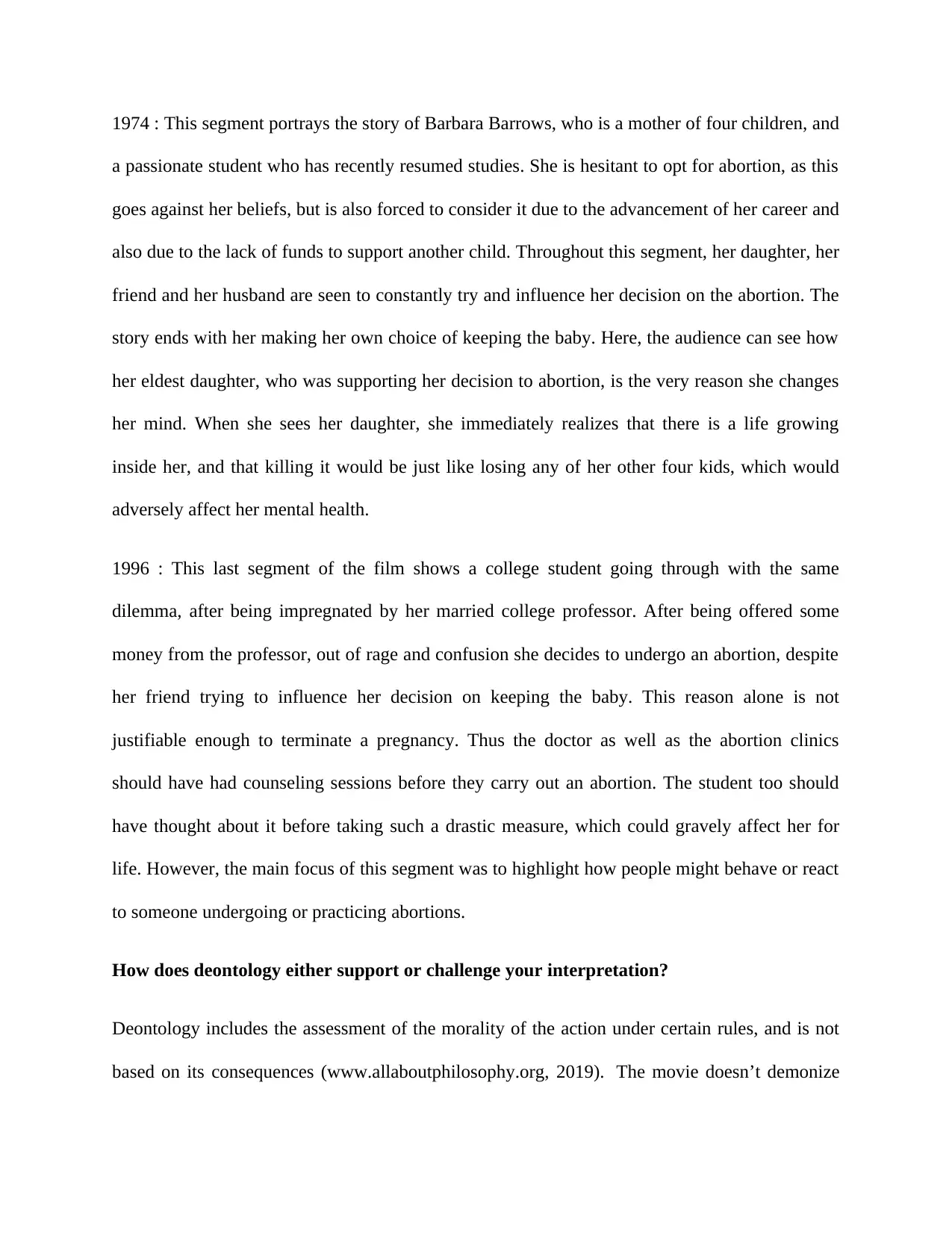
1974 : This segment portrays the story of Barbara Barrows, who is a mother of four children, and
a passionate student who has recently resumed studies. She is hesitant to opt for abortion, as this
goes against her beliefs, but is also forced to consider it due to the advancement of her career and
also due to the lack of funds to support another child. Throughout this segment, her daughter, her
friend and her husband are seen to constantly try and influence her decision on the abortion. The
story ends with her making her own choice of keeping the baby. Here, the audience can see how
her eldest daughter, who was supporting her decision to abortion, is the very reason she changes
her mind. When she sees her daughter, she immediately realizes that there is a life growing
inside her, and that killing it would be just like losing any of her other four kids, which would
adversely affect her mental health.
1996 : This last segment of the film shows a college student going through with the same
dilemma, after being impregnated by her married college professor. After being offered some
money from the professor, out of rage and confusion she decides to undergo an abortion, despite
her friend trying to influence her decision on keeping the baby. This reason alone is not
justifiable enough to terminate a pregnancy. Thus the doctor as well as the abortion clinics
should have had counseling sessions before they carry out an abortion. The student too should
have thought about it before taking such a drastic measure, which could gravely affect her for
life. However, the main focus of this segment was to highlight how people might behave or react
to someone undergoing or practicing abortions.
How does deontology either support or challenge your interpretation?
Deontology includes the assessment of the morality of the action under certain rules, and is not
based on its consequences (www.allaboutphilosophy.org, 2019). The movie doesn’t demonize
a passionate student who has recently resumed studies. She is hesitant to opt for abortion, as this
goes against her beliefs, but is also forced to consider it due to the advancement of her career and
also due to the lack of funds to support another child. Throughout this segment, her daughter, her
friend and her husband are seen to constantly try and influence her decision on the abortion. The
story ends with her making her own choice of keeping the baby. Here, the audience can see how
her eldest daughter, who was supporting her decision to abortion, is the very reason she changes
her mind. When she sees her daughter, she immediately realizes that there is a life growing
inside her, and that killing it would be just like losing any of her other four kids, which would
adversely affect her mental health.
1996 : This last segment of the film shows a college student going through with the same
dilemma, after being impregnated by her married college professor. After being offered some
money from the professor, out of rage and confusion she decides to undergo an abortion, despite
her friend trying to influence her decision on keeping the baby. This reason alone is not
justifiable enough to terminate a pregnancy. Thus the doctor as well as the abortion clinics
should have had counseling sessions before they carry out an abortion. The student too should
have thought about it before taking such a drastic measure, which could gravely affect her for
life. However, the main focus of this segment was to highlight how people might behave or react
to someone undergoing or practicing abortions.
How does deontology either support or challenge your interpretation?
Deontology includes the assessment of the morality of the action under certain rules, and is not
based on its consequences (www.allaboutphilosophy.org, 2019). The movie doesn’t demonize
⊘ This is a preview!⊘
Do you want full access?
Subscribe today to unlock all pages.

Trusted by 1+ million students worldwide
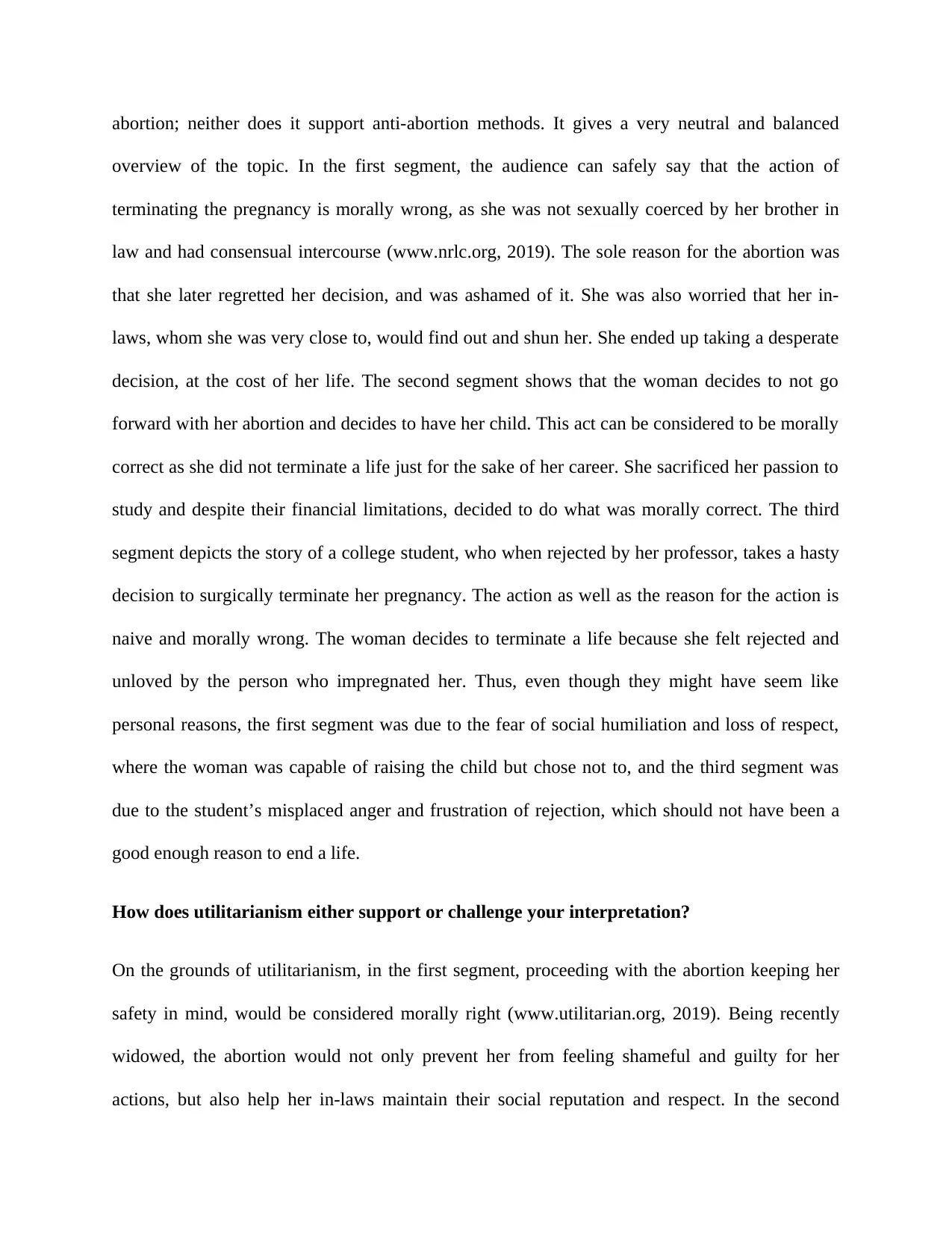
abortion; neither does it support anti-abortion methods. It gives a very neutral and balanced
overview of the topic. In the first segment, the audience can safely say that the action of
terminating the pregnancy is morally wrong, as she was not sexually coerced by her brother in
law and had consensual intercourse (www.nrlc.org, 2019). The sole reason for the abortion was
that she later regretted her decision, and was ashamed of it. She was also worried that her in-
laws, whom she was very close to, would find out and shun her. She ended up taking a desperate
decision, at the cost of her life. The second segment shows that the woman decides to not go
forward with her abortion and decides to have her child. This act can be considered to be morally
correct as she did not terminate a life just for the sake of her career. She sacrificed her passion to
study and despite their financial limitations, decided to do what was morally correct. The third
segment depicts the story of a college student, who when rejected by her professor, takes a hasty
decision to surgically terminate her pregnancy. The action as well as the reason for the action is
naive and morally wrong. The woman decides to terminate a life because she felt rejected and
unloved by the person who impregnated her. Thus, even though they might have seem like
personal reasons, the first segment was due to the fear of social humiliation and loss of respect,
where the woman was capable of raising the child but chose not to, and the third segment was
due to the student’s misplaced anger and frustration of rejection, which should not have been a
good enough reason to end a life.
How does utilitarianism either support or challenge your interpretation?
On the grounds of utilitarianism, in the first segment, proceeding with the abortion keeping her
safety in mind, would be considered morally right (www.utilitarian.org, 2019). Being recently
widowed, the abortion would not only prevent her from feeling shameful and guilty for her
actions, but also help her in-laws maintain their social reputation and respect. In the second
overview of the topic. In the first segment, the audience can safely say that the action of
terminating the pregnancy is morally wrong, as she was not sexually coerced by her brother in
law and had consensual intercourse (www.nrlc.org, 2019). The sole reason for the abortion was
that she later regretted her decision, and was ashamed of it. She was also worried that her in-
laws, whom she was very close to, would find out and shun her. She ended up taking a desperate
decision, at the cost of her life. The second segment shows that the woman decides to not go
forward with her abortion and decides to have her child. This act can be considered to be morally
correct as she did not terminate a life just for the sake of her career. She sacrificed her passion to
study and despite their financial limitations, decided to do what was morally correct. The third
segment depicts the story of a college student, who when rejected by her professor, takes a hasty
decision to surgically terminate her pregnancy. The action as well as the reason for the action is
naive and morally wrong. The woman decides to terminate a life because she felt rejected and
unloved by the person who impregnated her. Thus, even though they might have seem like
personal reasons, the first segment was due to the fear of social humiliation and loss of respect,
where the woman was capable of raising the child but chose not to, and the third segment was
due to the student’s misplaced anger and frustration of rejection, which should not have been a
good enough reason to end a life.
How does utilitarianism either support or challenge your interpretation?
On the grounds of utilitarianism, in the first segment, proceeding with the abortion keeping her
safety in mind, would be considered morally right (www.utilitarian.org, 2019). Being recently
widowed, the abortion would not only prevent her from feeling shameful and guilty for her
actions, but also help her in-laws maintain their social reputation and respect. In the second
Paraphrase This Document
Need a fresh take? Get an instant paraphrase of this document with our AI Paraphraser
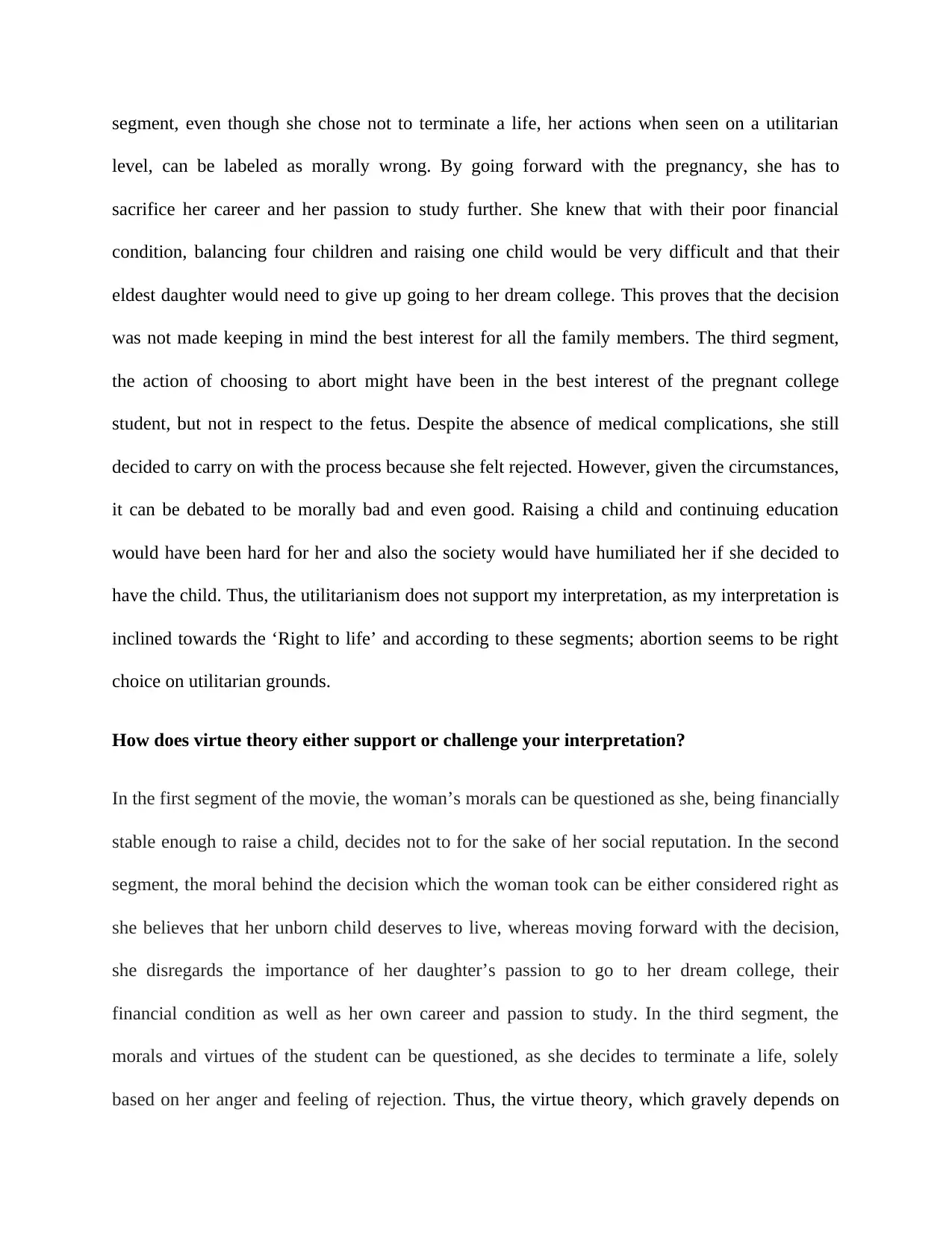
segment, even though she chose not to terminate a life, her actions when seen on a utilitarian
level, can be labeled as morally wrong. By going forward with the pregnancy, she has to
sacrifice her career and her passion to study further. She knew that with their poor financial
condition, balancing four children and raising one child would be very difficult and that their
eldest daughter would need to give up going to her dream college. This proves that the decision
was not made keeping in mind the best interest for all the family members. The third segment,
the action of choosing to abort might have been in the best interest of the pregnant college
student, but not in respect to the fetus. Despite the absence of medical complications, she still
decided to carry on with the process because she felt rejected. However, given the circumstances,
it can be debated to be morally bad and even good. Raising a child and continuing education
would have been hard for her and also the society would have humiliated her if she decided to
have the child. Thus, the utilitarianism does not support my interpretation, as my interpretation is
inclined towards the ‘Right to life’ and according to these segments; abortion seems to be right
choice on utilitarian grounds.
How does virtue theory either support or challenge your interpretation?
In the first segment of the movie, the woman’s morals can be questioned as she, being financially
stable enough to raise a child, decides not to for the sake of her social reputation. In the second
segment, the moral behind the decision which the woman took can be either considered right as
she believes that her unborn child deserves to live, whereas moving forward with the decision,
she disregards the importance of her daughter’s passion to go to her dream college, their
financial condition as well as her own career and passion to study. In the third segment, the
morals and virtues of the student can be questioned, as she decides to terminate a life, solely
based on her anger and feeling of rejection. Thus, the virtue theory, which gravely depends on
level, can be labeled as morally wrong. By going forward with the pregnancy, she has to
sacrifice her career and her passion to study further. She knew that with their poor financial
condition, balancing four children and raising one child would be very difficult and that their
eldest daughter would need to give up going to her dream college. This proves that the decision
was not made keeping in mind the best interest for all the family members. The third segment,
the action of choosing to abort might have been in the best interest of the pregnant college
student, but not in respect to the fetus. Despite the absence of medical complications, she still
decided to carry on with the process because she felt rejected. However, given the circumstances,
it can be debated to be morally bad and even good. Raising a child and continuing education
would have been hard for her and also the society would have humiliated her if she decided to
have the child. Thus, the utilitarianism does not support my interpretation, as my interpretation is
inclined towards the ‘Right to life’ and according to these segments; abortion seems to be right
choice on utilitarian grounds.
How does virtue theory either support or challenge your interpretation?
In the first segment of the movie, the woman’s morals can be questioned as she, being financially
stable enough to raise a child, decides not to for the sake of her social reputation. In the second
segment, the moral behind the decision which the woman took can be either considered right as
she believes that her unborn child deserves to live, whereas moving forward with the decision,
she disregards the importance of her daughter’s passion to go to her dream college, their
financial condition as well as her own career and passion to study. In the third segment, the
morals and virtues of the student can be questioned, as she decides to terminate a life, solely
based on her anger and feeling of rejection. Thus, the virtue theory, which gravely depends on
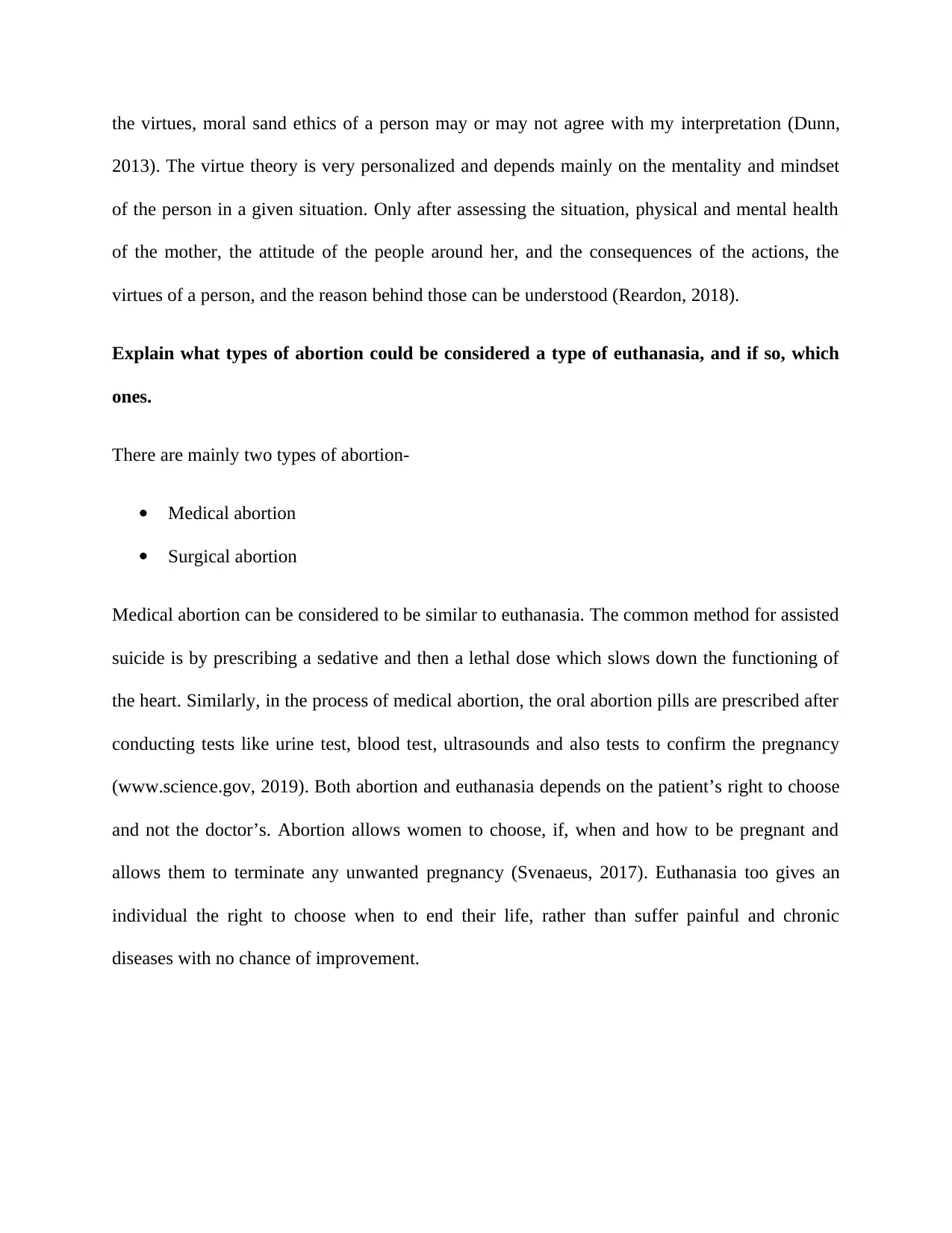
the virtues, moral sand ethics of a person may or may not agree with my interpretation (Dunn,
2013). The virtue theory is very personalized and depends mainly on the mentality and mindset
of the person in a given situation. Only after assessing the situation, physical and mental health
of the mother, the attitude of the people around her, and the consequences of the actions, the
virtues of a person, and the reason behind those can be understood (Reardon, 2018).
Explain what types of abortion could be considered a type of euthanasia, and if so, which
ones.
There are mainly two types of abortion-
Medical abortion
Surgical abortion
Medical abortion can be considered to be similar to euthanasia. The common method for assisted
suicide is by prescribing a sedative and then a lethal dose which slows down the functioning of
the heart. Similarly, in the process of medical abortion, the oral abortion pills are prescribed after
conducting tests like urine test, blood test, ultrasounds and also tests to confirm the pregnancy
(www.science.gov, 2019). Both abortion and euthanasia depends on the patient’s right to choose
and not the doctor’s. Abortion allows women to choose, if, when and how to be pregnant and
allows them to terminate any unwanted pregnancy (Svenaeus, 2017). Euthanasia too gives an
individual the right to choose when to end their life, rather than suffer painful and chronic
diseases with no chance of improvement.
2013). The virtue theory is very personalized and depends mainly on the mentality and mindset
of the person in a given situation. Only after assessing the situation, physical and mental health
of the mother, the attitude of the people around her, and the consequences of the actions, the
virtues of a person, and the reason behind those can be understood (Reardon, 2018).
Explain what types of abortion could be considered a type of euthanasia, and if so, which
ones.
There are mainly two types of abortion-
Medical abortion
Surgical abortion
Medical abortion can be considered to be similar to euthanasia. The common method for assisted
suicide is by prescribing a sedative and then a lethal dose which slows down the functioning of
the heart. Similarly, in the process of medical abortion, the oral abortion pills are prescribed after
conducting tests like urine test, blood test, ultrasounds and also tests to confirm the pregnancy
(www.science.gov, 2019). Both abortion and euthanasia depends on the patient’s right to choose
and not the doctor’s. Abortion allows women to choose, if, when and how to be pregnant and
allows them to terminate any unwanted pregnancy (Svenaeus, 2017). Euthanasia too gives an
individual the right to choose when to end their life, rather than suffer painful and chronic
diseases with no chance of improvement.
⊘ This is a preview!⊘
Do you want full access?
Subscribe today to unlock all pages.

Trusted by 1+ million students worldwide
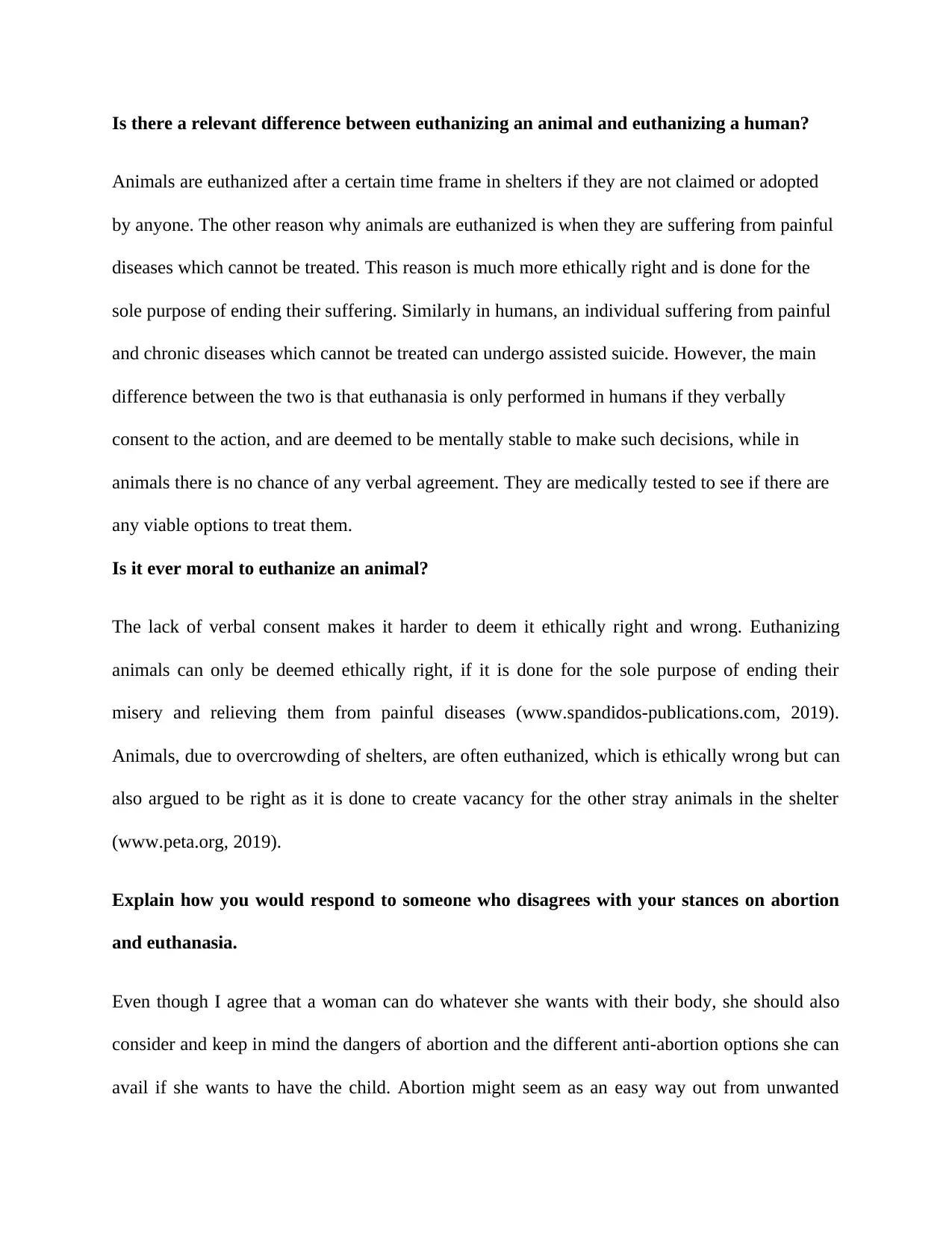
Is there a relevant difference between euthanizing an animal and euthanizing a human?
Animals are euthanized after a certain time frame in shelters if they are not claimed or adopted
by anyone. The other reason why animals are euthanized is when they are suffering from painful
diseases which cannot be treated. This reason is much more ethically right and is done for the
sole purpose of ending their suffering. Similarly in humans, an individual suffering from painful
and chronic diseases which cannot be treated can undergo assisted suicide. However, the main
difference between the two is that euthanasia is only performed in humans if they verbally
consent to the action, and are deemed to be mentally stable to make such decisions, while in
animals there is no chance of any verbal agreement. They are medically tested to see if there are
any viable options to treat them.
Is it ever moral to euthanize an animal?
The lack of verbal consent makes it harder to deem it ethically right and wrong. Euthanizing
animals can only be deemed ethically right, if it is done for the sole purpose of ending their
misery and relieving them from painful diseases (www.spandidos-publications.com, 2019).
Animals, due to overcrowding of shelters, are often euthanized, which is ethically wrong but can
also argued to be right as it is done to create vacancy for the other stray animals in the shelter
(www.peta.org, 2019).
Explain how you would respond to someone who disagrees with your stances on abortion
and euthanasia.
Even though I agree that a woman can do whatever she wants with their body, she should also
consider and keep in mind the dangers of abortion and the different anti-abortion options she can
avail if she wants to have the child. Abortion might seem as an easy way out from unwanted
Animals are euthanized after a certain time frame in shelters if they are not claimed or adopted
by anyone. The other reason why animals are euthanized is when they are suffering from painful
diseases which cannot be treated. This reason is much more ethically right and is done for the
sole purpose of ending their suffering. Similarly in humans, an individual suffering from painful
and chronic diseases which cannot be treated can undergo assisted suicide. However, the main
difference between the two is that euthanasia is only performed in humans if they verbally
consent to the action, and are deemed to be mentally stable to make such decisions, while in
animals there is no chance of any verbal agreement. They are medically tested to see if there are
any viable options to treat them.
Is it ever moral to euthanize an animal?
The lack of verbal consent makes it harder to deem it ethically right and wrong. Euthanizing
animals can only be deemed ethically right, if it is done for the sole purpose of ending their
misery and relieving them from painful diseases (www.spandidos-publications.com, 2019).
Animals, due to overcrowding of shelters, are often euthanized, which is ethically wrong but can
also argued to be right as it is done to create vacancy for the other stray animals in the shelter
(www.peta.org, 2019).
Explain how you would respond to someone who disagrees with your stances on abortion
and euthanasia.
Even though I agree that a woman can do whatever she wants with their body, she should also
consider and keep in mind the dangers of abortion and the different anti-abortion options she can
avail if she wants to have the child. Abortion might seem as an easy way out from unwanted
Paraphrase This Document
Need a fresh take? Get an instant paraphrase of this document with our AI Paraphraser
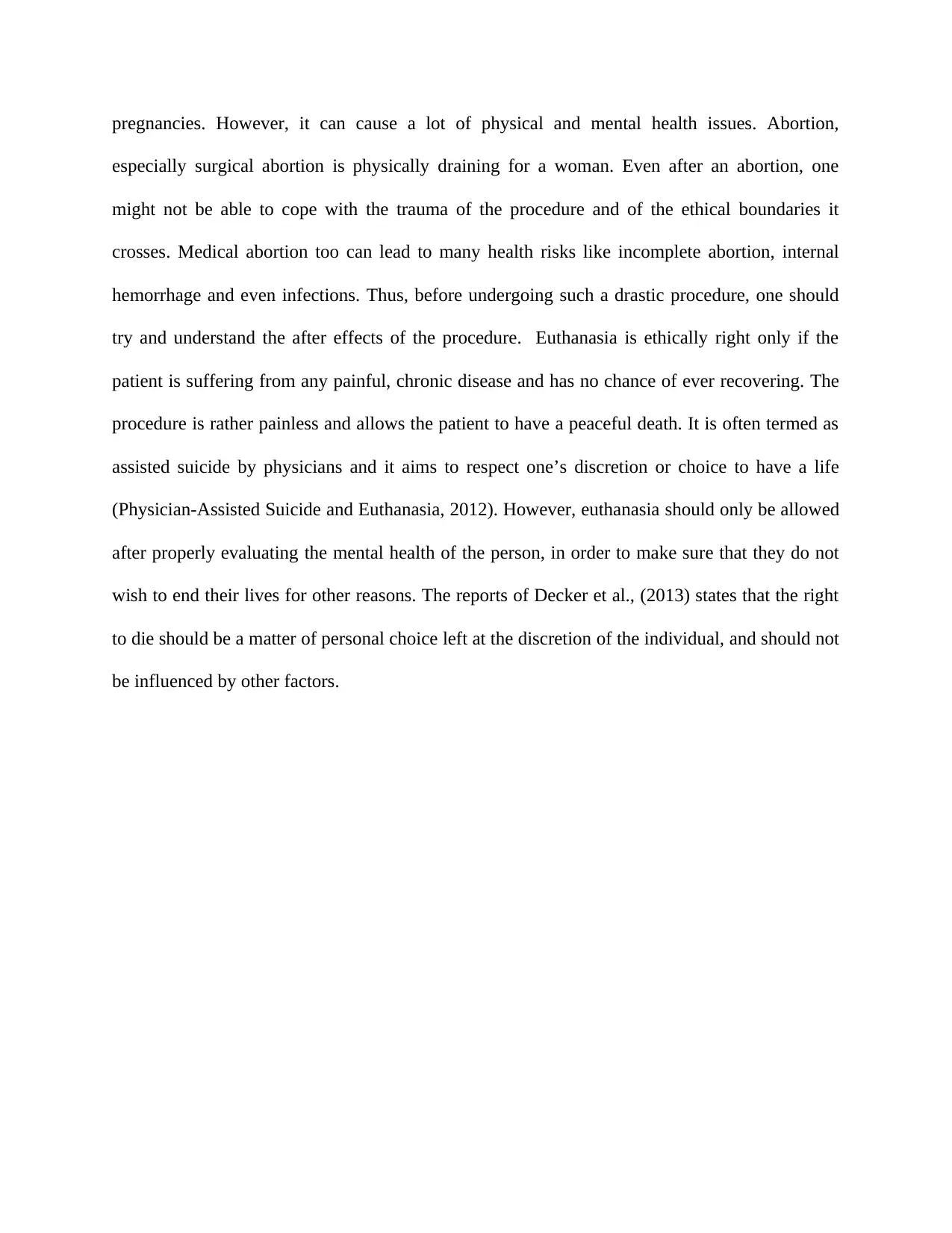
pregnancies. However, it can cause a lot of physical and mental health issues. Abortion,
especially surgical abortion is physically draining for a woman. Even after an abortion, one
might not be able to cope with the trauma of the procedure and of the ethical boundaries it
crosses. Medical abortion too can lead to many health risks like incomplete abortion, internal
hemorrhage and even infections. Thus, before undergoing such a drastic procedure, one should
try and understand the after effects of the procedure. Euthanasia is ethically right only if the
patient is suffering from any painful, chronic disease and has no chance of ever recovering. The
procedure is rather painless and allows the patient to have a peaceful death. It is often termed as
assisted suicide by physicians and it aims to respect one’s discretion or choice to have a life
(Physician-Assisted Suicide and Euthanasia, 2012). However, euthanasia should only be allowed
after properly evaluating the mental health of the person, in order to make sure that they do not
wish to end their lives for other reasons. The reports of Decker et al., (2013) states that the right
to die should be a matter of personal choice left at the discretion of the individual, and should not
be influenced by other factors.
especially surgical abortion is physically draining for a woman. Even after an abortion, one
might not be able to cope with the trauma of the procedure and of the ethical boundaries it
crosses. Medical abortion too can lead to many health risks like incomplete abortion, internal
hemorrhage and even infections. Thus, before undergoing such a drastic procedure, one should
try and understand the after effects of the procedure. Euthanasia is ethically right only if the
patient is suffering from any painful, chronic disease and has no chance of ever recovering. The
procedure is rather painless and allows the patient to have a peaceful death. It is often termed as
assisted suicide by physicians and it aims to respect one’s discretion or choice to have a life
(Physician-Assisted Suicide and Euthanasia, 2012). However, euthanasia should only be allowed
after properly evaluating the mental health of the person, in order to make sure that they do not
wish to end their lives for other reasons. The reports of Decker et al., (2013) states that the right
to die should be a matter of personal choice left at the discretion of the individual, and should not
be influenced by other factors.
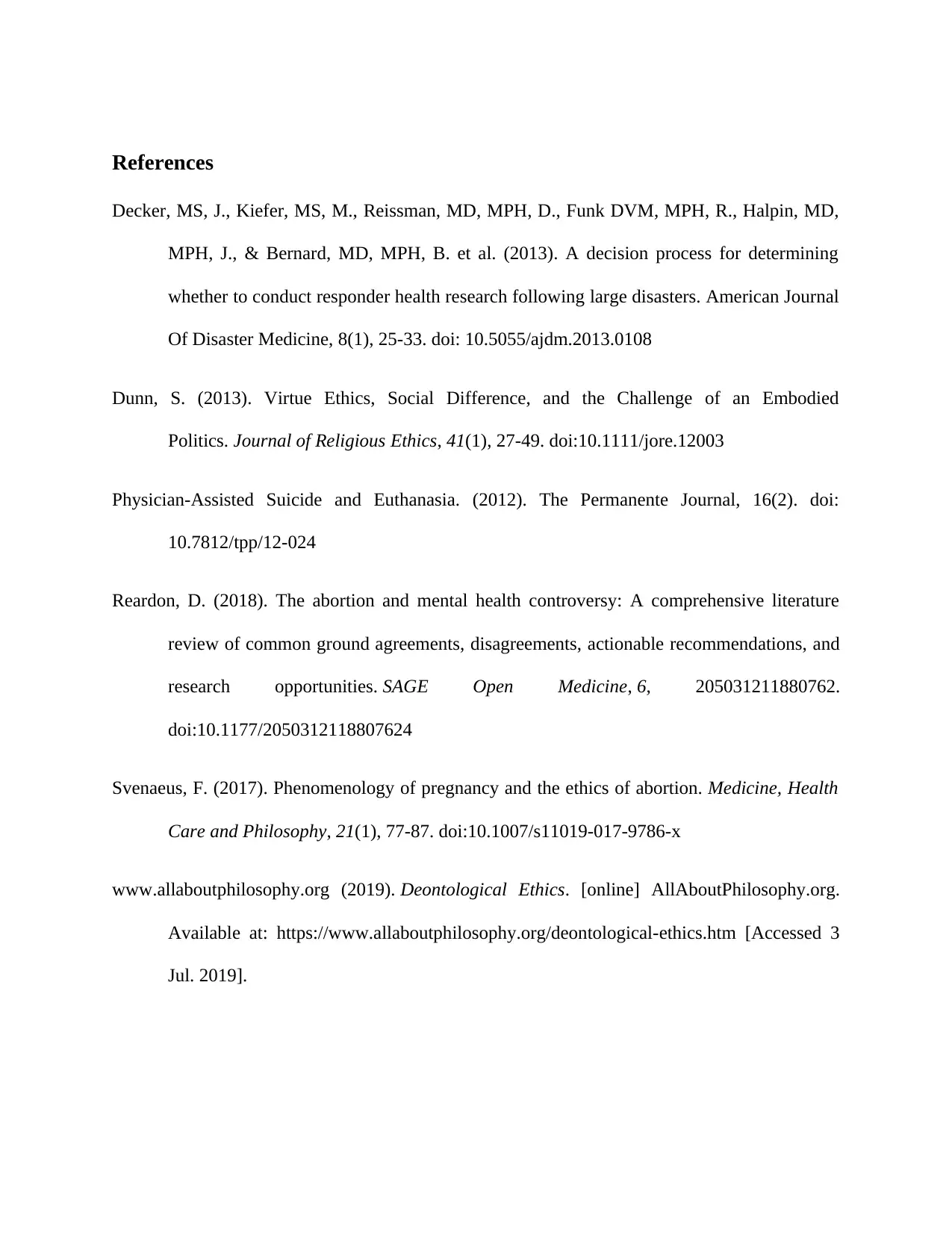
References
Decker, MS, J., Kiefer, MS, M., Reissman, MD, MPH, D., Funk DVM, MPH, R., Halpin, MD,
MPH, J., & Bernard, MD, MPH, B. et al. (2013). A decision process for determining
whether to conduct responder health research following large disasters. American Journal
Of Disaster Medicine, 8(1), 25-33. doi: 10.5055/ajdm.2013.0108
Dunn, S. (2013). Virtue Ethics, Social Difference, and the Challenge of an Embodied
Politics. Journal of Religious Ethics, 41(1), 27-49. doi:10.1111/jore.12003
Physician-Assisted Suicide and Euthanasia. (2012). The Permanente Journal, 16(2). doi:
10.7812/tpp/12-024
Reardon, D. (2018). The abortion and mental health controversy: A comprehensive literature
review of common ground agreements, disagreements, actionable recommendations, and
research opportunities. SAGE Open Medicine, 6, 205031211880762.
doi:10.1177/2050312118807624
Svenaeus, F. (2017). Phenomenology of pregnancy and the ethics of abortion. Medicine, Health
Care and Philosophy, 21(1), 77-87. doi:10.1007/s11019-017-9786-x
www.allaboutphilosophy.org (2019). Deontological Ethics. [online] AllAboutPhilosophy.org.
Available at: https://www.allaboutphilosophy.org/deontological-ethics.htm [Accessed 3
Jul. 2019].
Decker, MS, J., Kiefer, MS, M., Reissman, MD, MPH, D., Funk DVM, MPH, R., Halpin, MD,
MPH, J., & Bernard, MD, MPH, B. et al. (2013). A decision process for determining
whether to conduct responder health research following large disasters. American Journal
Of Disaster Medicine, 8(1), 25-33. doi: 10.5055/ajdm.2013.0108
Dunn, S. (2013). Virtue Ethics, Social Difference, and the Challenge of an Embodied
Politics. Journal of Religious Ethics, 41(1), 27-49. doi:10.1111/jore.12003
Physician-Assisted Suicide and Euthanasia. (2012). The Permanente Journal, 16(2). doi:
10.7812/tpp/12-024
Reardon, D. (2018). The abortion and mental health controversy: A comprehensive literature
review of common ground agreements, disagreements, actionable recommendations, and
research opportunities. SAGE Open Medicine, 6, 205031211880762.
doi:10.1177/2050312118807624
Svenaeus, F. (2017). Phenomenology of pregnancy and the ethics of abortion. Medicine, Health
Care and Philosophy, 21(1), 77-87. doi:10.1007/s11019-017-9786-x
www.allaboutphilosophy.org (2019). Deontological Ethics. [online] AllAboutPhilosophy.org.
Available at: https://www.allaboutphilosophy.org/deontological-ethics.htm [Accessed 3
Jul. 2019].
⊘ This is a preview!⊘
Do you want full access?
Subscribe today to unlock all pages.

Trusted by 1+ million students worldwide
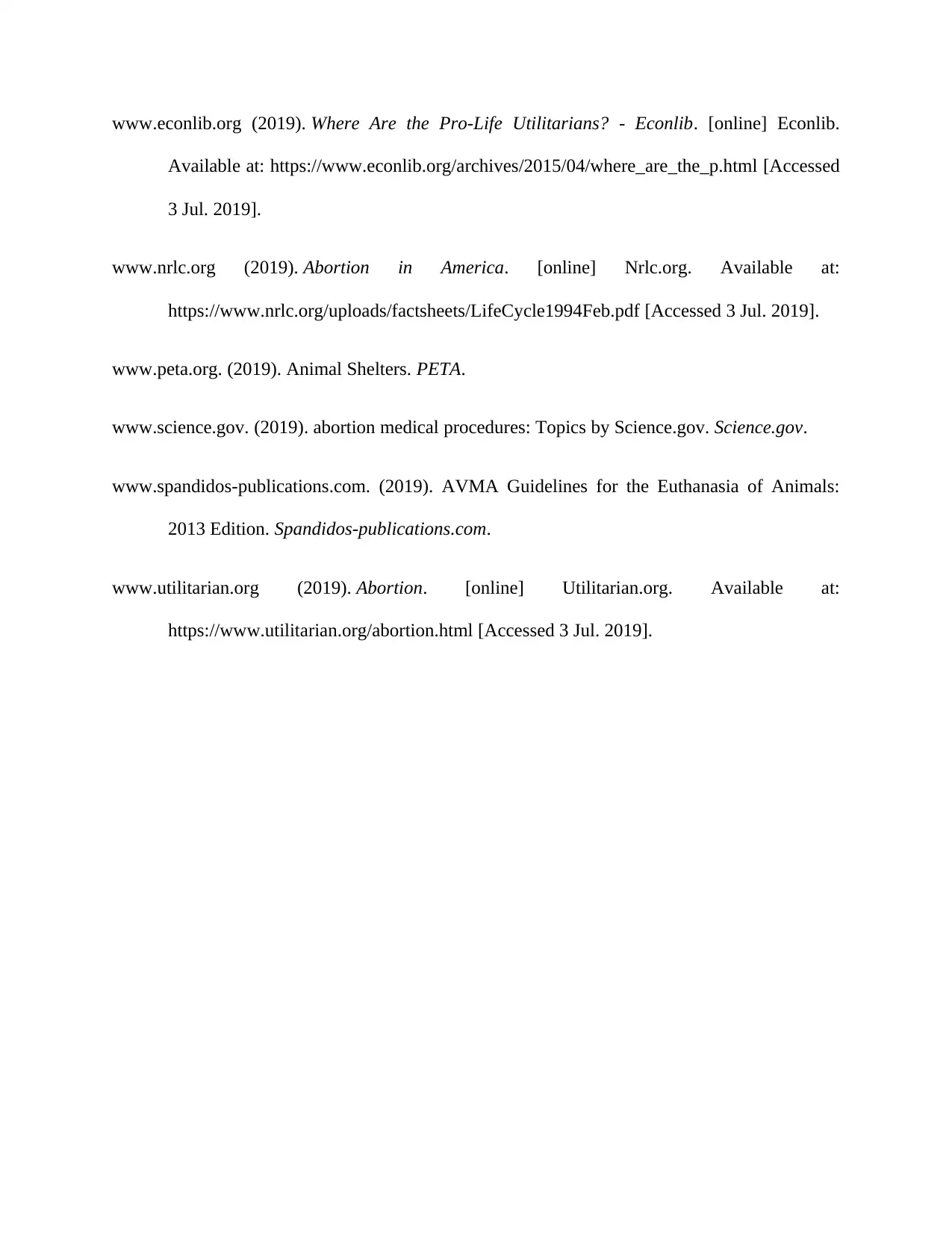
www.econlib.org (2019). Where Are the Pro-Life Utilitarians? - Econlib. [online] Econlib.
Available at: https://www.econlib.org/archives/2015/04/where_are_the_p.html [Accessed
3 Jul. 2019].
www.nrlc.org (2019). Abortion in America. [online] Nrlc.org. Available at:
https://www.nrlc.org/uploads/factsheets/LifeCycle1994Feb.pdf [Accessed 3 Jul. 2019].
www.peta.org. (2019). Animal Shelters. PETA.
www.science.gov. (2019). abortion medical procedures: Topics by Science.gov. Science.gov.
www.spandidos-publications.com. (2019). AVMA Guidelines for the Euthanasia of Animals:
2013 Edition. Spandidos-publications.com.
www.utilitarian.org (2019). Abortion. [online] Utilitarian.org. Available at:
https://www.utilitarian.org/abortion.html [Accessed 3 Jul. 2019].
Available at: https://www.econlib.org/archives/2015/04/where_are_the_p.html [Accessed
3 Jul. 2019].
www.nrlc.org (2019). Abortion in America. [online] Nrlc.org. Available at:
https://www.nrlc.org/uploads/factsheets/LifeCycle1994Feb.pdf [Accessed 3 Jul. 2019].
www.peta.org. (2019). Animal Shelters. PETA.
www.science.gov. (2019). abortion medical procedures: Topics by Science.gov. Science.gov.
www.spandidos-publications.com. (2019). AVMA Guidelines for the Euthanasia of Animals:
2013 Edition. Spandidos-publications.com.
www.utilitarian.org (2019). Abortion. [online] Utilitarian.org. Available at:
https://www.utilitarian.org/abortion.html [Accessed 3 Jul. 2019].
1 out of 10
Your All-in-One AI-Powered Toolkit for Academic Success.
+13062052269
info@desklib.com
Available 24*7 on WhatsApp / Email
![[object Object]](/_next/static/media/star-bottom.7253800d.svg)
Unlock your academic potential
Copyright © 2020–2025 A2Z Services. All Rights Reserved. Developed and managed by ZUCOL.
